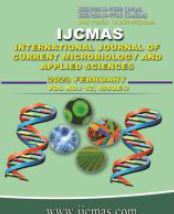


 National Academy of Agricultural Sciences (NAAS)
National Academy of Agricultural Sciences (NAAS)

|
PRINT ISSN : 2319-7692
Online ISSN : 2319-7706 Issues : 12 per year Publisher : Excellent Publishers Email : editorijcmas@gmail.com / submit@ijcmas.com Editor-in-chief: Dr.M.Prakash Index Copernicus ICV 2018: 95.39 NAAS RATING 2020: 5.38 |
Moringa oleifera, traditionally consumed in some countries, is now widely distributed throughout the tropics, particularly in Africa. It is consumed in the form of food supplements in Côte d'Ivoire. However, the production method of Moringa leaf powder could be a source of contamination by potentially mycotoxigenic moulds. The objective of this work was to evaluate the level of contamination of Moringa powder by Aspergillus Spp strains and to detect the genes involved in the biosynthesis of aflatoxin B1. A total of 288 samples of Moringa powder were collected from vendors in six communes of Abidjan district. Isolation and purification of Aspergillus isolates were performed on Sabouraud medium with chloramphenicol. The identification of these strains was carried out by macroscopic and microscopic observations. The molecular aspect of the Aspergillus species and the detection of the Nor, Ver, AvfA and AflR1 genes, involved in the biosynthesis process of aflatoxin B1, were carried out by PCR. The results show that the contamination rate of Moringa powder by Aspergillus spp was 62.46% with a predominance of Aspergillus niger (33.16%). Other species namely Aspergillus flavus (27.07%), Aspergillus fumigatus (24.87%) and Aspergillus terreus (13.98%) were also observed. The prevalences of strains harbouring the AflR1, Nor, Ver, and AvfA genes were 70.47%, 73.07%, 52.85% and 41.97% respectively. Strains harbouring AflR, Nor, Ver, and AvfA genes simultaneously were also detected in proportions of 39.37%. The presence of Aspergillus harbouring the genes coding for Aflatoxin B1 biosynthesis in Moringa powder could constitute a health risk for the consumer.
 |
 |
 |
 |
 |